tire size GMC YUKON 2020 User Guide
[x] Cancel search | Manufacturer: GMC, Model Year: 2020, Model line: YUKON, Model: GMC YUKON 2020Pages: 434, PDF Size: 6.45 MB
Page 336 of 434
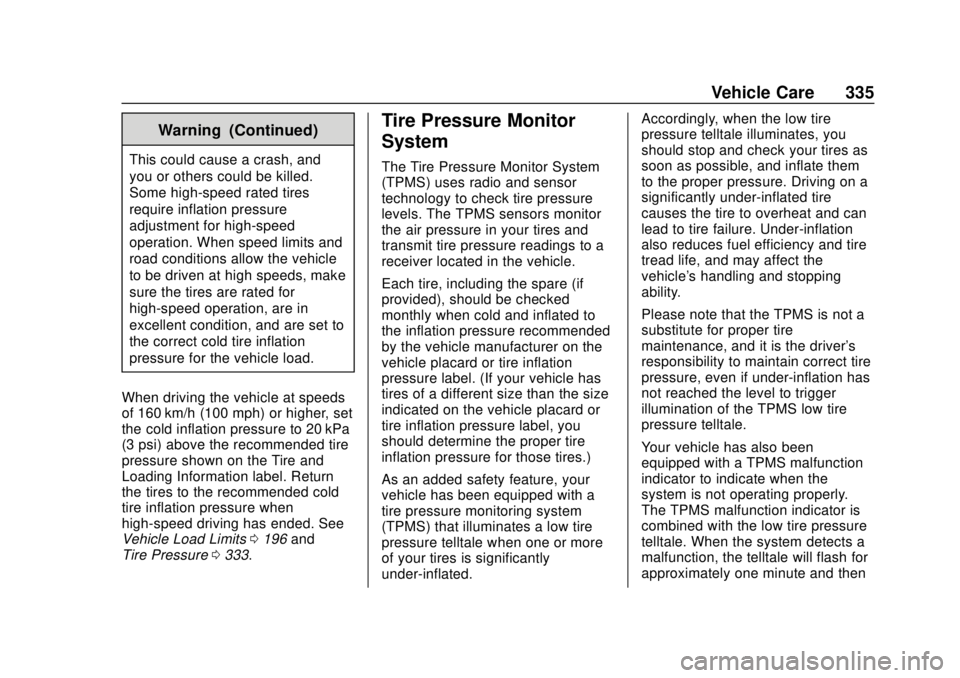
GMC Yukon/Yukon XL/Denali Owner Manual (GMNA-Localizing-U.S./
Canada/Mexico-13566587) - 2020 - CRC - 4/15/19
Vehicle Care 335
Warning (Continued)
This could cause a crash, and
you or others could be killed.
Some high-speed rated tires
require inflation pressure
adjustment for high-speed
operation. When speed limits and
road conditions allow the vehicle
to be driven at high speeds, make
sure the tires are rated for
high-speed operation, are in
excellent condition, and are set to
the correct cold tire inflation
pressure for the vehicle load.
When driving the vehicle at speeds
of 160 km/h (100 mph) or higher, set
the cold inflation pressure to 20 kPa
(3 psi) above the recommended tire
pressure shown on the Tire and
Loading Information label. Return
the tires to the recommended cold
tire inflation pressure when
high-speed driving has ended. See
Vehicle Load Limits 0196 and
Tire Pressure 0333.
Tire Pressure Monitor
System
The Tire Pressure Monitor System
(TPMS) uses radio and sensor
technology to check tire pressure
levels. The TPMS sensors monitor
the air pressure in your tires and
transmit tire pressure readings to a
receiver located in the vehicle.
Each tire, including the spare (if
provided), should be checked
monthly when cold and inflated to
the inflation pressure recommended
by the vehicle manufacturer on the
vehicle placard or tire inflation
pressure label. (If your vehicle has
tires of a different size than the size
indicated on the vehicle placard or
tire inflation pressure label, you
should determine the proper tire
inflation pressure for those tires.)
As an added safety feature, your
vehicle has been equipped with a
tire pressure monitoring system
(TPMS) that illuminates a low tire
pressure telltale when one or more
of your tires is significantly
under-inflated. Accordingly, when the low tire
pressure telltale illuminates, you
should stop and check your tires as
soon as possible, and inflate them
to the proper pressure. Driving on a
significantly under-inflated tire
causes the tire to overheat and can
lead to tire failure. Under-inflation
also reduces fuel efficiency and tire
tread life, and may affect the
vehicle's handling and stopping
ability.
Please note that the TPMS is not a
substitute for proper tire
maintenance, and it is the driver's
responsibility to maintain correct tire
pressure, even if under-inflation has
not reached the level to trigger
illumination of the TPMS low tire
pressure telltale.
Your vehicle has also been
equipped with a TPMS malfunction
indicator to indicate when the
system is not operating properly.
The TPMS malfunction indicator is
combined with the low tire pressure
telltale. When the system detects a
malfunction, the telltale will flash for
approximately one minute and then
Page 337 of 434
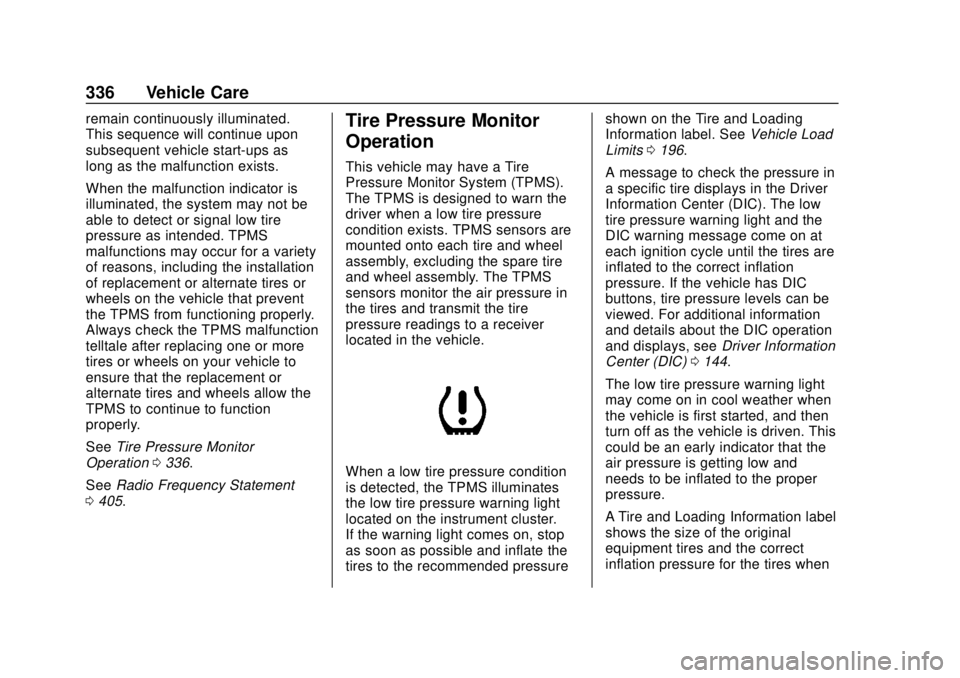
GMC Yukon/Yukon XL/Denali Owner Manual (GMNA-Localizing-U.S./
Canada/Mexico-13566587) - 2020 - CRC - 4/15/19
336 Vehicle Care
remain continuously illuminated.
This sequence will continue upon
subsequent vehicle start-ups as
long as the malfunction exists.
When the malfunction indicator is
illuminated, the system may not be
able to detect or signal low tire
pressure as intended. TPMS
malfunctions may occur for a variety
of reasons, including the installation
of replacement or alternate tires or
wheels on the vehicle that prevent
the TPMS from functioning properly.
Always check the TPMS malfunction
telltale after replacing one or more
tires or wheels on your vehicle to
ensure that the replacement or
alternate tires and wheels allow the
TPMS to continue to function
properly.
SeeTire Pressure Monitor
Operation 0336.
See Radio Frequency Statement
0 405.Tire Pressure Monitor
Operation
This vehicle may have a Tire
Pressure Monitor System (TPMS).
The TPMS is designed to warn the
driver when a low tire pressure
condition exists. TPMS sensors are
mounted onto each tire and wheel
assembly, excluding the spare tire
and wheel assembly. The TPMS
sensors monitor the air pressure in
the tires and transmit the tire
pressure readings to a receiver
located in the vehicle.
When a low tire pressure condition
is detected, the TPMS illuminates
the low tire pressure warning light
located on the instrument cluster.
If the warning light comes on, stop
as soon as possible and inflate the
tires to the recommended pressure shown on the Tire and Loading
Information label. See
Vehicle Load
Limits 0196.
A message to check the pressure in
a specific tire displays in the Driver
Information Center (DIC). The low
tire pressure warning light and the
DIC warning message come on at
each ignition cycle until the tires are
inflated to the correct inflation
pressure. If the vehicle has DIC
buttons, tire pressure levels can be
viewed. For additional information
and details about the DIC operation
and displays, see Driver Information
Center (DIC) 0144.
The low tire pressure warning light
may come on in cool weather when
the vehicle is first started, and then
turn off as the vehicle is driven. This
could be an early indicator that the
air pressure is getting low and
needs to be inflated to the proper
pressure.
A Tire and Loading Information label
shows the size of the original
equipment tires and the correct
inflation pressure for the tires when
Page 341 of 434

GMC Yukon/Yukon XL/Denali Owner Manual (GMNA-Localizing-U.S./
Canada/Mexico-13566587) - 2020 - CRC - 4/15/19
340 Vehicle Care
8. Proceed to the passenger sidefront tire, and repeat the
procedure in Step 7.
9. Proceed to the passenger side rear tire, and repeat the
procedure in Step 7.
10. Proceed to the driver side rear tire, and repeat the procedure
in Step 7. The horn sounds two
times to indicate the sensor
identification code has been
matched to the driver side rear
tire, and the TPMS sensor
matching process is no longer
active. The TIRE LEARNING
ACTIVE message on the DIC
display screen goes off.
11. Turn the vehicle off.
12. Set all four tires to the recommended air pressure
level as indicated on the Tire
and Loading Information label.Tire Inspection
We recommend that the tires,
including the spare tire, if the
vehicle has one, be inspected
for signs of wear or damage at
least once a month.
Replace the tire if:
.The indicators at three or
more places around the tire
can be seen.
.There is cord or fabric
showing through the tire's
rubber.
.The tread or sidewall is
cracked, cut, or snagged
deep enough to show cord or
fabric.
.The tire has a bump, bulge,
or split.
.The tire has a puncture, cut,
or other damage that cannot
be repaired well because of
the size or location of the
damage.
Tire Rotation
Tires should be rotated every
12 000 km (7,500 mi). See
Maintenance Schedule 0379.
Tires are rotated to achieve a
uniform wear for all tires. The
first rotation is the most
important.
Anytime unusual wear is
noticed, rotate the tires as soon
as possible, check for proper tire
inflation pressure, and check for
damaged tires or wheels. If the
unusual wear continues after the
rotation, check the wheel
alignment. See When It Is Time
for New Tires 0341 and
Wheel Replacement 0346.
Page 343 of 434
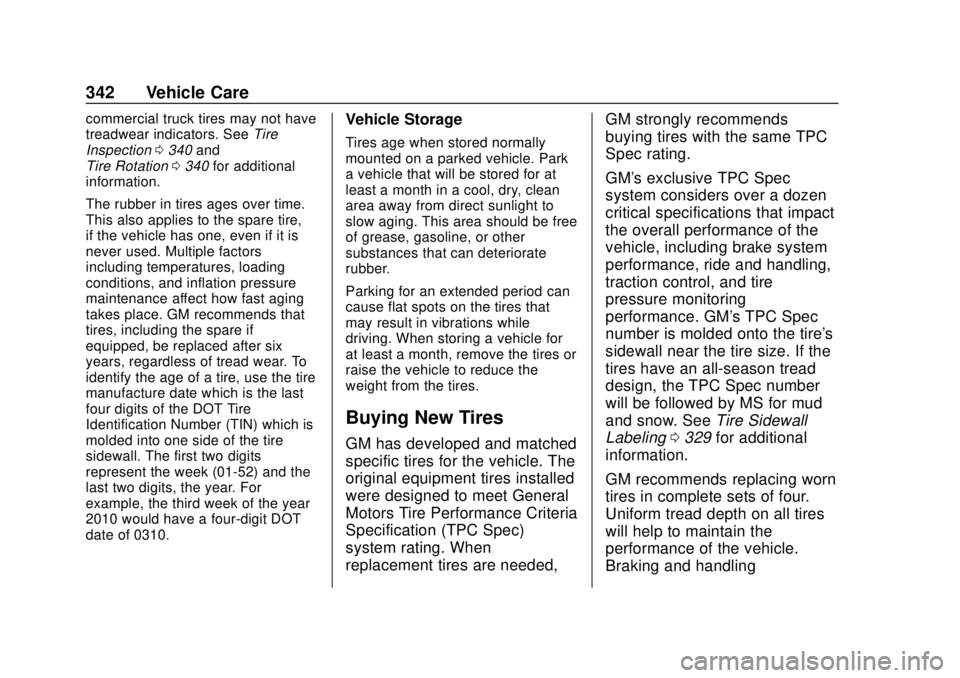
GMC Yukon/Yukon XL/Denali Owner Manual (GMNA-Localizing-U.S./
Canada/Mexico-13566587) - 2020 - CRC - 4/15/19
342 Vehicle Care
commercial truck tires may not have
treadwear indicators. SeeTire
Inspection 0340 and
Tire Rotation 0340 for additional
information.
The rubber in tires ages over time.
This also applies to the spare tire,
if the vehicle has one, even if it is
never used. Multiple factors
including temperatures, loading
conditions, and inflation pressure
maintenance affect how fast aging
takes place. GM recommends that
tires, including the spare if
equipped, be replaced after six
years, regardless of tread wear. To
identify the age of a tire, use the tire
manufacture date which is the last
four digits of the DOT Tire
Identification Number (TIN) which is
molded into one side of the tire
sidewall. The first two digits
represent the week (01-52) and the
last two digits, the year. For
example, the third week of the year
2010 would have a four-digit DOT
date of 0310.Vehicle Storage
Tires age when stored normally
mounted on a parked vehicle. Park
a vehicle that will be stored for at
least a month in a cool, dry, clean
area away from direct sunlight to
slow aging. This area should be free
of grease, gasoline, or other
substances that can deteriorate
rubber.
Parking for an extended period can
cause flat spots on the tires that
may result in vibrations while
driving. When storing a vehicle for
at least a month, remove the tires or
raise the vehicle to reduce the
weight from the tires.
Buying New Tires
GM has developed and matched
specific tires for the vehicle. The
original equipment tires installed
were designed to meet General
Motors Tire Performance Criteria
Specification (TPC Spec)
system rating. When
replacement tires are needed, GM strongly recommends
buying tires with the same TPC
Spec rating.
GM's exclusive TPC Spec
system considers over a dozen
critical specifications that impact
the overall performance of the
vehicle, including brake system
performance, ride and handling,
traction control, and tire
pressure monitoring
performance. GM's TPC Spec
number is molded onto the tire's
sidewall near the tire size. If the
tires have an all-season tread
design, the TPC Spec number
will be followed by MS for mud
and snow. See
Tire Sidewall
Labeling 0329 for additional
information.
GM recommends replacing worn
tires in complete sets of four.
Uniform tread depth on all tires
will help to maintain the
performance of the vehicle.
Braking and handling
Page 344 of 434

GMC Yukon/Yukon XL/Denali Owner Manual (GMNA-Localizing-U.S./
Canada/Mexico-13566587) - 2020 - CRC - 4/15/19
Vehicle Care 343
performance may be adversely
affected if all the tires are not
replaced at the same time.
If proper rotation and
maintenance have been done,
all four tires should wear out at
about the same time. SeeTire
Rotation 0340 for information
on proper tire rotation. However,
if it is necessary to replace only
one axle set of worn tires, place
the new tires on the rear axle.
{Warning
Tires could explode during
improper service. Attempting
to mount or dismount a tire
could cause injury or death.
Only your dealer or authorized
tire service center should
mount or dismount the tires.
{Warning
Mixing tires of different sizes,
tread patterns, or types on the
same axle may cause loss of
control of the vehicle, resulting
in a crash or other vehicle
damage. Use the same size,
load range, and type of tires
as the original tires.
This vehicle may have a
different size spare than the
road tires originally installed
on the vehicle. When new, the
vehicle included a spare tire
and wheel assembly with a
similar overall diameter as the
road tires and wheels, so it is
all right to drive on it. The
spare tire was developed for
use on this vehicle and will not
affect vehicle handling.{Warning
Using bias-ply tires on the
vehicle may cause the wheel
rim flanges to develop cracks
after many miles of driving.
A tire and/or wheel could fail
suddenly and cause a crash.
Use only radial-ply tires with
the wheels on the vehicle.
Winter tires with the same speed
rating as the original equipment
tires may not be available for H,
V, W, Y and ZR speed rated
tires. Never exceed the winter
tires’ maximum speed capability
when using winter tires with a
lower speed rating.
If the vehicle tires must be
replaced with a tire that does not
have a TPC Spec number, make
sure they are the same size,
load range, speed rating, and
construction (radial) as the
original tires.
Page 345 of 434
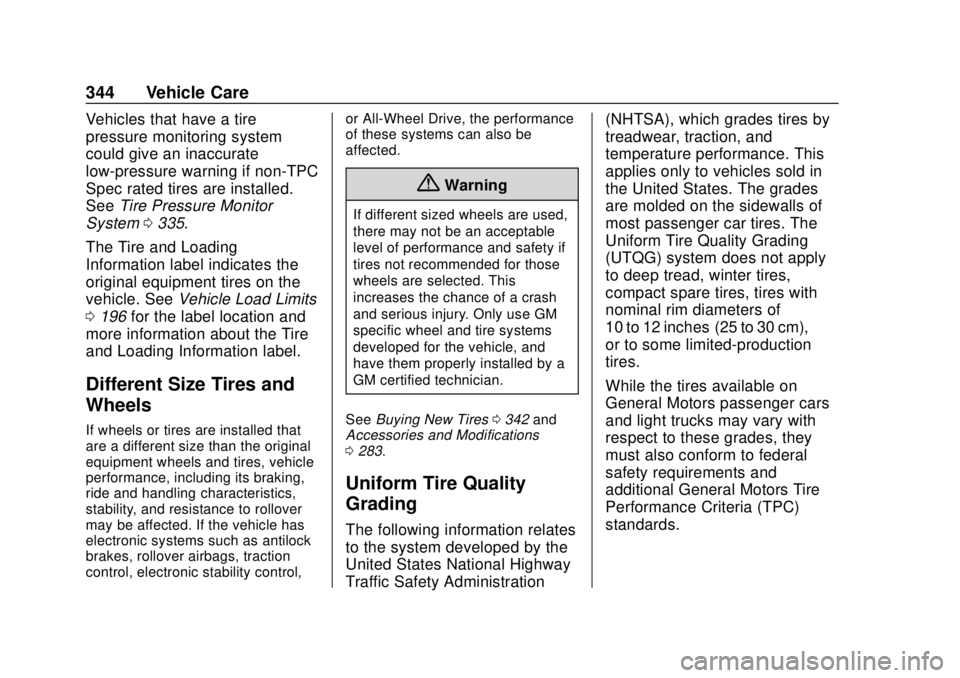
GMC Yukon/Yukon XL/Denali Owner Manual (GMNA-Localizing-U.S./
Canada/Mexico-13566587) - 2020 - CRC - 4/15/19
344 Vehicle Care
Vehicles that have a tire
pressure monitoring system
could give an inaccurate
low-pressure warning if non-TPC
Spec rated tires are installed.
SeeTire Pressure Monitor
System 0335.
The Tire and Loading
Information label indicates the
original equipment tires on the
vehicle. See Vehicle Load Limits
0 196 for the label location and
more information about the Tire
and Loading Information label.
Different Size Tires and
Wheels
If wheels or tires are installed that
are a different size than the original
equipment wheels and tires, vehicle
performance, including its braking,
ride and handling characteristics,
stability, and resistance to rollover
may be affected. If the vehicle has
electronic systems such as antilock
brakes, rollover airbags, traction
control, electronic stability control, or All-Wheel Drive, the performance
of these systems can also be
affected.
{Warning
If different sized wheels are used,
there may not be an acceptable
level of performance and safety if
tires not recommended for those
wheels are selected. This
increases the chance of a crash
and serious injury. Only use GM
specific wheel and tire systems
developed for the vehicle, and
have them properly installed by a
GM certified technician.
See Buying New Tires 0342 and
Accessories and Modifications
0 283.
Uniform Tire Quality
Grading
The following information relates
to the system developed by the
United States National Highway
Traffic Safety Administration (NHTSA), which grades tires by
treadwear, traction, and
temperature performance. This
applies only to vehicles sold in
the United States. The grades
are molded on the sidewalls of
most passenger car tires. The
Uniform Tire Quality Grading
(UTQG) system does not apply
to deep tread, winter tires,
compact spare tires, tires with
nominal rim diameters of
10 to 12 inches (25 to 30 cm),
or to some limited-production
tires.
While the tires available on
General Motors passenger cars
and light trucks may vary with
respect to these grades, they
must also conform to federal
safety requirements and
additional General Motors Tire
Performance Criteria (TPC)
standards.
Page 348 of 434
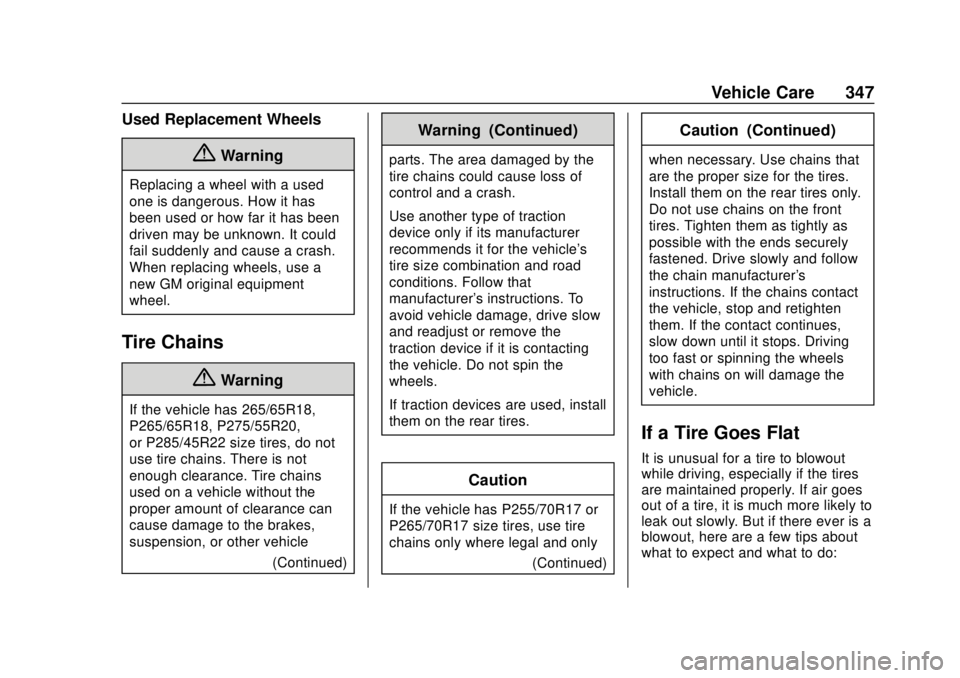
GMC Yukon/Yukon XL/Denali Owner Manual (GMNA-Localizing-U.S./
Canada/Mexico-13566587) - 2020 - CRC - 4/15/19
Vehicle Care 347
Used Replacement Wheels
{Warning
Replacing a wheel with a used
one is dangerous. How it has
been used or how far it has been
driven may be unknown. It could
fail suddenly and cause a crash.
When replacing wheels, use a
new GM original equipment
wheel.
Tire Chains
{Warning
If the vehicle has 265/65R18,
P265/65R18, P275/55R20,
or P285/45R22 size tires, do not
use tire chains. There is not
enough clearance. Tire chains
used on a vehicle without the
proper amount of clearance can
cause damage to the brakes,
suspension, or other vehicle(Continued)
Warning (Continued)
parts. The area damaged by the
tire chains could cause loss of
control and a crash.
Use another type of traction
device only if its manufacturer
recommends it for the vehicle's
tire size combination and road
conditions. Follow that
manufacturer's instructions. To
avoid vehicle damage, drive slow
and readjust or remove the
traction device if it is contacting
the vehicle. Do not spin the
wheels.
If traction devices are used, install
them on the rear tires.
Caution
If the vehicle has P255/70R17 or
P265/70R17 size tires, use tire
chains only where legal and only(Continued)
Caution (Continued)
when necessary. Use chains that
are the proper size for the tires.
Install them on the rear tires only.
Do not use chains on the front
tires. Tighten them as tightly as
possible with the ends securely
fastened. Drive slowly and follow
the chain manufacturer's
instructions. If the chains contact
the vehicle, stop and retighten
them. If the contact continues,
slow down until it stops. Driving
too fast or spinning the wheels
with chains on will damage the
vehicle.
If a Tire Goes Flat
It is unusual for a tire to blowout
while driving, especially if the tires
are maintained properly. If air goes
out of a tire, it is much more likely to
leak out slowly. But if there ever is a
blowout, here are a few tips about
what to expect and what to do:
Page 360 of 434
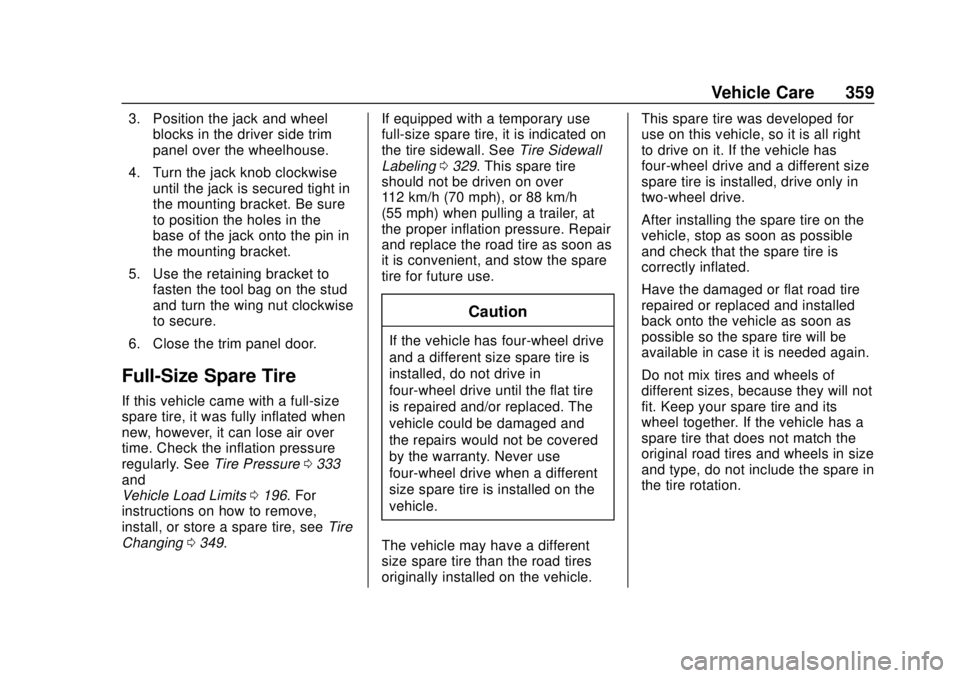
GMC Yukon/Yukon XL/Denali Owner Manual (GMNA-Localizing-U.S./
Canada/Mexico-13566587) - 2020 - CRC - 4/15/19
Vehicle Care 359
3. Position the jack and wheelblocks in the driver side trim
panel over the wheelhouse.
4. Turn the jack knob clockwise until the jack is secured tight in
the mounting bracket. Be sure
to position the holes in the
base of the jack onto the pin in
the mounting bracket.
5. Use the retaining bracket to fasten the tool bag on the stud
and turn the wing nut clockwise
to secure.
6. Close the trim panel door.
Full-Size Spare Tire
If this vehicle came with a full-size
spare tire, it was fully inflated when
new, however, it can lose air over
time. Check the inflation pressure
regularly. See Tire Pressure0333
and
Vehicle Load Limits 0196. For
instructions on how to remove,
install, or store a spare tire, see Tire
Changing 0349. If equipped with a temporary use
full-size spare tire, it is indicated on
the tire sidewall. See
Tire Sidewall
Labeling 0329. This spare tire
should not be driven on over
112 km/h (70 mph), or 88 km/h
(55 mph) when pulling a trailer, at
the proper inflation pressure. Repair
and replace the road tire as soon as
it is convenient, and stow the spare
tire for future use.
Caution
If the vehicle has four-wheel drive
and a different size spare tire is
installed, do not drive in
four-wheel drive until the flat tire
is repaired and/or replaced. The
vehicle could be damaged and
the repairs would not be covered
by the warranty. Never use
four-wheel drive when a different
size spare tire is installed on the
vehicle.
The vehicle may have a different
size spare tire than the road tires
originally installed on the vehicle. This spare tire was developed for
use on this vehicle, so it is all right
to drive on it. If the vehicle has
four-wheel drive and a different size
spare tire is installed, drive only in
two-wheel drive.
After installing the spare tire on the
vehicle, stop as soon as possible
and check that the spare tire is
correctly inflated.
Have the damaged or flat road tire
repaired or replaced and installed
back onto the vehicle as soon as
possible so the spare tire will be
available in case it is needed again.
Do not mix tires and wheels of
different sizes, because they will not
fit. Keep your spare tire and its
wheel together. If the vehicle has a
spare tire that does not match the
original road tires and wheels in size
and type, do not include the spare in
the tire rotation.
Page 426 of 434

GMC Yukon/Yukon XL/Denali Owner Manual (GMNA-Localizing-U.S./Cana-
da/Mexico-13566587) - 2020 - CRC - 4/15/19
Index 425
Fluid (cont'd)Four-Wheel Drive
Transfer Case . . . . . . . . . . . . . . . 219
Washer . . . . . . . . . . . . . . . . . . . . . . . 302
Fog Lamps . . . . . . . . . . . . . . . . . . . . . 169 Bulb Replacement . . . . . . . . . . . . 312
Folding Mirrors . . . . . . . . . . . . . . . . . . 38
Forward Collision Alert (FCA) System . . . . . . . . . . . . . . . . . 245
Four-Wheel Drive . . . . . . . . . . 219, 305
Four-Wheel-Drive Light . . . . . . . . . 139
Frequency Statement Radio . . . . . . . . . . . . . . . . . . . . . . . . . 405
Front Axle . . . . . . . . . . . . . . . . . . . . . . 306
Front Fog Lamp
Light . . . . . . . . . . . . . . . . . . . . . . . . . . 143
Front Seats Heated and Ventilated . . . . . . . . . . 54
Fuel Additives . . . . . . . . . . . . . . . . . . . . . 255
Economy, Driving for Better . . . 184
Filling a Portable FuelContainer . . . . . . . . . . . . . . . . . . . 258
Filling the Tank . . . . . . . . . . . . . . . 256
Foreign Countries . . . . . . . . . . . . 255
Gauge . . . . . . . . . . . . . . . . . . . . . . . . 130
Low Fuel Warning Light . . . . . . . 142
Management, Active . . . . . . . . . . .211 Fuel (cont'd)
Prohibited Fuels . . . . . . . . . . . . . . 255
Recommended . . . . . . . . . . . . . . . 254
Top Tier . . . . . . . . . . . . . . . . . . . . . . 254
Full-Size Spare Tire . . . . . . . . . . . . 359
Fuses Engine Compartment FuseBlock . . . . . . . . . . . . . . . . . . . . . . . . 315
Fuses and Circuit Breakers . . . 315
Instrument Panel Fuse
Block . . . . . . . . . . . . . . . . . . . 320, 323
Rear Compartment Fuse Block . . . . . . . . . . . . . . . . . . . . . . . . 325
G
Garage Door Opener . . . . . . . . . . . 160Programming . . . . . . . . . . . . . . . . . 160
Gas Strut(s) . . . . . . . . . . . . . . . . . . . . 310
Gauges Engine CoolantTemperature . . . . . . . . . . . . . . . . 131
Engine Oil Pressure . . . . . . . . . . 130
Fuel . . . . . . . . . . . . . . . . . . . . . . . . . . 130
Odometer . . . . . . . . . . . . . . . . . . . . . 129
Speedometer . . . . . . . . . . . . . . . . . 129
Tachometer . . . . . . . . . . . . . . . . . . . 129
Transmission Temperature . . . . 132
Trip Odometer . . . . . . . . . . . . . . . . 129 Gauges (cont'd)
Voltmeter . . . . . . . . . . . . . . . . . . . . . 133
Warning Lights and
Indicators . . . . . . . . . . . . . . . . . . . 125
General Information Service and Maintenance . . . . . 377
Towing . . . . . . . . . . . . . . . . . . . . . . . . 259
Vehicle Care . . . . . . . . . . . . . . . . . . 282
Glass Replacement . . . . . . . . . . . . . 310
Glove Box . . . . . . . . . . . . . . . . . . . . . . 109
GM Mobility Reimbursement
Program . . . . . . . . . . . . . . . . . . . . . . . 399
H
Hazard Warning Flashers . . . . . . . 168
Head Restraints . . . . . . . . . . . . . . . . . 47
Head-up Display . . . . . . . . . . . . . . . . 147
HeadlampsAiming . . . . . . . . . . . . . . . . . . . . . . . . 312
Automatic . . . . . . . . . . . . . . . . . . . . . 167
Bulb Replacement . . . . . . . . . . . . 312
Daytime Running
Lamps (DRL) . . . . . . . . . . . . . . . . 167
Flash-to-Pass . . . . . . . . . . . . . . . . . 167
High Intensity Discharge
(HID) Lighting . . . . . . . . . . . . . . . 312
High-Beam On Light . . . . . . . . . . 143
High/Low Beam Changer . . . . . 166
Page 432 of 434

GMC Yukon/Yukon XL/Denali Owner Manual (GMNA-Localizing-U.S./Cana-
da/Mexico-13566587) - 2020 - CRC - 4/15/19
Index 431
Throttle, Adjustable . . . . . . . . . . . . . 201
Time . . . . . . . . . . . . . . . . . . . . . . . . . . . . 119
Tires . . . . . . . . . . . . . . . . . . . . . . . . . . . . 326All-Season . . . . . . . . . . . . . . . . . . . . 327
All-Terrain . . . . . . . . . . . . . . . . . . . . 328
Buying New Tires . . . . . . . . . . . . . 342
Chains . . . . . . . . . . . . . . . . . . . . . . . . 347
Changing . . . . . . . . . . . . . . . . . . . . . 349
Designations . . . . . . . . . . . . . . . . . 330
Different Size . . . . . . . . . . . . . . . . . 344
Full-Size Spare . . . . . . . . . . . . . . . 359
If a Tire Goes Flat . . . . . . . . . . . . 347
Inspection . . . . . . . . . . . . . . . . . . . . 340
Low Profile . . . . . . . . . . . . . . . . . . . 328
Pressure . . . . . . . . . . . . . . . . . 333, 334
Pressure Light . . . . . . . . . . . . . . . . 141
Pressure Monitor Operation . . 336
Pressure Monitor System . . . . . 335
Rotation . . . . . . . . . . . . . . . . . . . . . . 340
Sidewall Labeling . . . . . . . . . . . . . 329
Terminology and Definitions . . 331
Uniform Tire QualityGrading . . . . . . . . . . . . . . . . . . . . . 344
Wheel Alignment and Tire Balance . . . . . . . . . . . . . . . . . . . . . 346
Wheel Replacement . . . . . . . . . . 346
When It Is Time for New Tires . . . . . . . . . . . . . . . . . . . . . . . . 341 Tires (cont'd)
Winter . . . . . . . . . . . . . . . . . . . . . . . . 328
Top Tier Fuel . . . . . . . . . . . . . . . . . . . 254
Tow/Haul Mode . . . . . . . . . . . . . . . . . 218
Tow/Haul Mode Light . . . . . . . . . . . 139
Towing Driving Characteristics . . . . . . . . 259
Equipment . . . . . . . . . . . . . . . . . . . . 270
General Information . . . . . . . . . . 259
Recreational Vehicle . . . . . . . . . . 364
Trailer . . . . . . . . . . . . . . . . . . . . . . . . 264
Trailer Sway Control (TSC) . . . 278
Vehicle . . . . . . . . . . . . . . . . . . . . . . . 363
Traction
Control System(TCS)/StabiliTrak Light . . . . . . 141
Off Light . . . . . . . . . . . . . . . . . . . . . . 140
Traction Control/Electronic
Stability Control . . . . . . . . . . . . . . . 226
Trailer Sway Control (TSC) . . . . . . . . . . 278
Towing . . . . . . . . . . . . . . . . . . . . . . . . 264
Transfer Case . . . . . . . . . . . . . . . . . . 219
Transmission
Automatic . . . . . . . . . . . . . . . . . . . . . 213
Fluid, Automatic . . . . . . . . . 292, 295
Temperature Gauge . . . . . . . . . . 132 Transportation Program,
Courtesy . . . . . . . . . . . . . . . . . . . . . . 402
Trip Odometer . . . . . . . . . . . . . . . . . . 129
Turn and Lane-Change Signals . . . . . . . . . . . . . . . . . . . . . . . . 169
U
Uniform Tire Quality Grading . . . 344
Universal Remote System . . . . . . 160Operation . . . . . . . . . . . . . . . . . . . . . 163
Programming . . . . . . . . . . . . . . . . . 160
Using This Manual . . . . . . . . . . . . . . . . 2
V
Vehicle
Alarm System . . . . . . . . . . . . . . . . . . 33
Canadian Owners . . . . . . . . . . . . . . . 2
Control . . . . . . . . . . . . . . . . . . . . . . . 186
Identification Number (VIN) . . . 392
Load Limits . . . . . . . . . . . . . . . . . . . 196
Messages . . . . . . . . . . . . . . . . . . . . 151
Personalization . . . . . . . . . . . . . . . 152
Remote Start . . . . . . . . . . . . . . . . . . . 23
Security . . . . . . . . . . . . . . . . . . . . . . . . 33
Speed Messages . . . . . . . . . . . . . 152
Towing . . . . . . . . . . . . . . . . . . . . . . . . 363
Vehicle Ahead Indicator . . . . . . . . 140